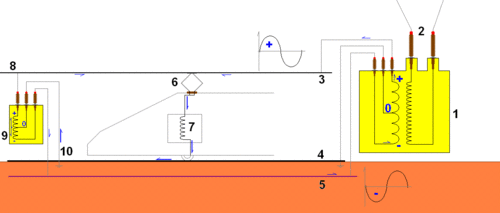
25 kV AC railway electrification
This article has multiple issues. Please help or discuss these issues on the talk page. (Learn how and when to remove these messages)
|

Railway electrification systems using alternating current (AC) at 25 kilovolts (kV) are used worldwide, especially for high-speed rail. It is usually supplied at the standard utility frequency (typically 50 or 60 Hz), which simplifies traction substations. The development of 25 kV AC electrification is closely connected with that of successfully using utility frequency.


This electrification is ideal for railways that cover long distances or carry heavy traffic. After some experimentation before World War II in Hungary and in the Black Forest in Germany, it came into widespread use in the 1950s.

One of the reasons it was not introduced earlier was the lack of suitable small and lightweight control and rectification equipment before the development of solid-state rectifiers and related technology. Another reason was the increased clearance required under bridges and in tunnels, which would have required major civil engineering in order to provide the increased clearance to live parts. Where existing loading gauges were more generous, this was less of an issue.

Railways using older, lower-capacity direct-current systems have introduced or are introducing 25 kV AC instead of 3 kV DC/1.5 kV DC for their new high-speed lines.

History
The first successful operational and regular use of a utility frequency system dates back to 1931, tests having run since 1922. It was developed by Kálmán Kandó in Hungary, who used 16 kV AC at 50 Hz, asynchronous traction, and an adjustable number of (motor) poles. The first electrified line for testing was Budapest–Dunakeszi–Alag. The first fully electrified line was Budapest–Győr–Hegyeshalom (part of the Budapest–Vienna line).[1] Although Kandó's solution showed a way for the future, railway operators outside of Hungary showed a lack of interest in the design.

The first railway to use this system was completed in 1936 by the Deutsche Reichsbahn who electrified part of the Höllentalbahn between Freiburg and Neustadt installing a 20 kV 50 Hz AC system. This part of Germany was in the French zone of occupation after 1945. As a result of examining the German system in 1951 the SNCF electrified the line between Aix-les-Bains and La Roche-sur-Foron in southern France, initially at the same 20 kV but converted to 25 kV in 1953. The 25 kV system was then adopted as standard in France, but since substantial amounts of mileage south of Paris had already been electrified at 1.5 kV DC, SNCF also continued some major new DC electrification projects, until dual-voltage locomotives were developed in the 1960s.[2][3]

The main reason why electrification using utility frequency had not been widely adopted before was the lack of reliability of Mercury arc rectifiers that could fit on the train. This in turn related to the requirement to use DC series motors, which required the current to be converted from AC to DC and for that a rectifier is needed. Until the early 1950s, mercury-arc rectifiers were difficult to operate even in ideal conditions and were therefore unsuitable for use in railway locomotives.

It was possible to use AC motors (and some railways did, with varying success), but they have had less than ideal characteristics for traction purposes. This is because control of speed is difficult without varying the frequency and reliance on voltage to control speed gives a torque at any given speed that is not ideal. This is why DC series motors were the most common choice for traction purposes until the 1990s, as they can be controlled by voltage, and have an almost ideal torque vs speed characteristic.

In the 1990s, high-speed trains began to use lighter, lower-maintenance three-phase AC induction motors. The N700 Shinkansen uses a three-level converter to convert 25 kV single-phase AC to 1,520 V AC (via transformer) to 3 kV DC (via phase-controlled rectifier with thyristor) to a maximum 2,300 V three-phase AC (via a variable voltage, variable frequency inverter using IGBTs with pulse-width modulation) to run the motors. The system works in reverse for regenerative braking.

The choice of 25 kV was related to the efficiency of power transmission as a function of voltage and cost, not based on a neat and tidy ratio of the supply voltage. For a given power level, a higher voltage allows for a lower current and usually better efficiency at the greater cost for high-voltage equipment. It was found that 25 kV was an optimal point, where a higher voltage would still improve efficiency but not by a significant amount in relation to the higher costs incurred by the need for larger insulators and greater clearance from structures.

To avoid short circuits, the high voltage must be protected from moisture. Weather events, such as "the wrong type of snow", have caused failures in the past. An example of atmospheric causes occurred in December 2009, when four Eurostar trains broke down inside the Channel Tunnel.

Distribution
Electric power for 25 kV AC electrification is usually taken directly from the three-phase transmission system. At the transmission substation, a step-down transformer is connected across two of the three phases of the high-voltage supply and lowers the voltage to 25 kV. This is then fed, sometimes several kilometres away, to a railway feeder station located beside the tracks. Switchgear at feeder stations, and at track sectioning cabins located halfway between feeder stations, provides switching to feed the overhead line from adjacent feeder stations if one feeder station loses grid supply.

Since only two phases of the high-voltage supply are used, phase imbalance is corrected by connecting each feeder station to a different combination of phases. To avoid the train pantograph bridging together two feeder stations which may be out-of-phase with each other, neutral sections are provided at feeder stations and track sectioning cabins. SVCs are used for load balancing and voltage control.[4]

In some cases dedicated single-phase AC power lines were built to substations with single phase AC transformers. Such lines were built to supply the French TGV.[5]

Standardisation
Railway electrification using 25 kV, 50 Hz AC has become an international standard. There are two main standards that define the voltages of the system:

- EN 50163:2004+A1:2007 – "Railway applications. Supply voltages of traction systems"[6]
- IEC 60850 – "Railway Applications. Supply voltages of traction systems"[7]
The permissible range of voltages allowed are as stated in the above standards and take into account the number of trains drawing current and their distance from the substation.

| Electrification system |
Voltage | ||||
|---|---|---|---|---|---|
| Min. non-permanent |
Min. permanent |
Nominal | Max. permanent |
Max. non-permanent | |
| 25 kV 50 Hz | 17.5 kV | 19 kV | 25 kV | 27.5 kV | 29 kV |
This system is now part of the European Union's Trans-European railway interoperability standards (1996/48/EC "Interoperability of the Trans-European high-speed rail system" and 2001/16/EC "Interoperability of the Trans-European Conventional rail system").

Variations
Systems based on this standard but with some variations have been used.

25 kV AC at 60 Hz
In countries where 60 Hz is the normal grid power frequency, 25 kV at 60 Hz is used for the railway electrification.

- In Canada on the Deux-Montagnes line of the Montreal Metropolitan transportation Agency.
- In Japan on the Tokaido, Sanyo and Kyushu Shinkansen lines (using 1,435 mm or 4 ft 8+1⁄2 in gauge).
- In South Korea on the Korail network.
- In Taiwan on the Taiwan High Speed Rail line (using 1,435 mm or 4 ft 8+1⁄2 in gauge) and on Taiwan Railway Administration's electrified lines (using 1,067 mm or 3 ft 6 in gauge).
- In the United States on newer electrified portions of the Northeast Corridor (i.e. the New Haven-Boston segment) intercity passenger lines, New Jersey Transit commuter lines, Denver RTD Commuter Rail, Caltrain, and select isolated short lines.
20 kV AC at 50 or 60 Hz
In Japan, this is used on existing railway lines in Tohoku Region, Hokuriku Region, Hokkaido and Kyushu, of which Hokuriku and Kyushu are at 60 Hz.

12.5 kV AC at 60 Hz
Some lines in the United States have been electrified at 12.5 kV 60 Hz or converted from 11 kV 25 Hz to 12.5 kV 60 Hz. Use of 60 Hz allows direct supply from the 60 Hz utility grid yet does not require the larger wire clearance for 25 kV 60 Hz or require dual-voltage capability for trains also operating on 11 kV 25 Hz lines. Examples are:

- Metro-North Railroad's New Haven Line from Pelham, NY to New Haven, CT (Since 1985; previously 11 kV 25 Hz).
12 kV at 25 Hz
- New Jersey Transit's North Jersey Coast Line from Matawan, NJ to Long Branch, NJ (1988–2002; changed to 25 kV 60 Hz).
- Amtrak
- SEPTA – Both ex-Reading Rail and ex-Pennsylvania Rail sides.
6.25 kV AC
Early 50 Hz AC railway electrification in the United Kingdom was planned to use sections at 6.25 kV AC where there was limited clearance under bridges and in tunnels. Rolling stock was dual-voltage with automatic switching between 25 kV and 6.25 kV. The 6.25 kV sections were converted to 25 kV AC as a result of research work that demonstrated that the distance between live and earthed equipment could be reduced from that originally thought to be necessary.

The research was done using a steam engine beneath a bridge at Crewe. A section of 25 kV overhead line was gradually brought closer to the earthed metalwork of the bridge whilst being subjected to steam from the locomotive's chimney. The distance at which a flashover occurred was measured and this was used as a basis from which new clearances between overhead equipment and structures were derived.[citation needed]

50 kV AC
Occasionally 25 kV is doubled to 50 kV to obtain greater power and increase the distance between substations. Such lines are usually isolated from other lines to avoid complications from interrunning. Examples are:

- The Sishen–Saldanha iron ore railway (50 Hz).
- The Deseret Power Railway which is an isolated coal railway (60 Hz).[8]
- The now closed Black Mesa and Lake Powell Railroad which was also an isolated coal railway (60 Hz).
- The now closed Tumbler Ridge Subdivision of BC Rail (60 Hz).[9]
2 × 25 kV autotransformer system

2. Power supply
3. Overhead line
4. Running rail
5. Feeder line
6. Pantograph
7. Locomotive transformer
8. Overhead line
9. Autotransformer
10. Running rail
The 2 × 25 kV autotransformer system is a split-phase electric power system which supplies 25 kV power to the trains, but transmits power at 50 kV to reduce energy losses. It should not be confused with the 50 kV system. In this system, the current is mainly carried between the overhead line and a feeder transmission line instead of the rail. The overhead line (3) and feeder (5) are on opposite phases so the voltage between them is 50 kV, while the voltage between the overhead line (3) and the running rails (4) remains at 25 kV. Periodic autotransformers (9) divert the return current from the neutral rail, step it up, and send it along the feeder line.

This system was initially deployed on San'yō Shinkansen in Japan in 1972 and in Paris-Lyon High speed rail line in France in 1981,[10] and has gone on to be used by New Zealand Railways in 1988,[11]Indian Railways,[12] Russian Railways, Italian High Speed Railways, UK High Speed 1, most of the West Coast Main Line and Crossrail,[13] with some parts of older lines being gradually converted,[citation needed] French lines (LGV lines and some other lines[14]), most Spanish high-speed rail lines,[15] Amtrak and some of the Finnish and Hungarian lines.


The 2 x 25 system traces its roots back in the upgrading of the electrification of the New York, New Haven and Hartford Railroad witch was electrified in 1907 and upgraded in 1914. The line was initially electrified with 11 kV 25 Hz system and then upgraded as "2 x 11 kV" system (but it was never named in this way).

Although the railroad considered the 1907 electrification highly successful, two problems required an ultimate redesign of the transmission system. The first was electromagnetic interference in adjacent, parallel telegraph and telephone wires caused by the high currents in the traction power system.

The second was that the system's geographic growth and the evolving state of electrical technology created a need for higher transmission voltages. The railroad could have simply raised the operating voltage of the entire system, however this would have required all the catenary insulators to be upgraded to withstand a higher potential, and replacement of all the locomotive high voltage equipment. And while higher transmission voltages had become common in the seven years since the initial electrification, generators were still limited by economics to a maximum output voltage of around 11 kV.

The solution decided upon by the railroad, after several years of study, was a balanced autotransformer system. [16][17][18][19][20][21][22][23][24]

Boosted voltage
For TGV world speed record runs in France the voltage was temporarily boosted, to 29.5 kV[25] and 31 kV at different times.[26]

25 kV on broad gauge lines
- In Argentina on the Roca Line (using 1,676 mm or 5 ft 6 in gauge).
- In Australia:
- Adelaide: part of the suburban network (50 Hz).
- Commonwealth of Independent States: parts of the network (50 Hz).
- In Finland: see rail transport in Finland (50 Hz).
- In India: see rail transport in India and Central Organisation for Railway Electrification (50 Hz).
- In Spain: the Atlantic Axis and the Madrid-Galicia HSL between Ourense and Santiago (50 Hz).
- In Portugal: see list of railway lines in Portugal (50 Hz).
25 kV on narrow gauge lines
- In Australia:
- Perth: entire suburban network, see railways in Perth (50 Hz).
- Queensland: see rail electrification in Queensland (50 Hz).
- In Malaysia: see rail transport in Malaysia (50 Hz).
- In New Zealand: see North Island Main Trunk and Auckland railway electrification (50 Hz).
- In South Africa: see rail transport in South Africa (25 and 50 kV 50 Hz).
- In Taiwan: see rail transport in Taiwan (60 Hz).
- In Thailand: see SRT Dark Red line and SRT Light Red line (50 Hz).
- In Tunisia: see rail transport in Tunisia (50 Hz).
Other voltages on 50 Hz electrification
- In France, Mont Blanc Tramway and Chemin de fer du Montenvers: 11 kV
- In Germany, Hambachbahn and Nord-Süd-Bahn: 6.6 kV
Multi-system locomotives and trains
Trains that can operate on more than one voltage, such as 3 kV and 25 kV, are established technologies. Some locomotives in Europe are capable of using four different voltage standards.[27]

See also
References
- ^ Hollingsworth, J. B.; Cook, Arthur F. (1998). The great book of trains : featuring 310 locomotives shown in more than 160 full-colour illustrations and 500 photographs. London: Salamander Books. pp. 254–255. ISBN 0-86101-919-9. OCLC 60209873.
- ^ Haydock, David (1991). SNCF. "Modern Railways" special. London: Ian Allan. ISBN 978-0-7110-1980-5
- ^ Cuynet, Jean (2005). La traction électrique en France 1900–2005. Paris: La Vie du Rail. ISBN 2-915034-38-9
- ^ SVCs for load balancing and trackside voltage control, ABB Power Technologies. [1] Archived 2007-02-06 at the Wayback Machine
- ^ TGV power Archived May 4, 2009, at the Wayback Machine
- ^ British Standards Institution (January 2005). BS EN 50163:2004+A1:2007 Railway Applications. Supply voltages of traction systems. doi:10.3403/30103554.
- ^ IEC 60850 – "Railway Applications. Supply voltages of traction systems"
- ^ "Railroad Coordination Manual Of Instruction, Section 2.1.5 Deseret Power Railway" (PDF). Utah Department of Transportation. May 2015. p. 102. Retrieved 8 November 2016.
- ^ "GF6C #6001 PRESERVED". West Coast Railway Association, BC. May 2004. Archived from the original on February 18, 2009. Retrieved 2011-01-09.
- ^ Courtois, C. (1993). "Why the 2*25 kV alternative? (autotransformer traction supply)". IEE Colloquium on 50kV Autotransformer Traction Supply Systems - the French Experience: 1/1–1/4.
- ^ Tom McGavin (Autumn 1988). "North Island Main Trunk Electrified". New Zealand Railway Observer. 45 (1). New Zealand Railway and Locomotive Society: 49. ISSN 0028-8624.
- ^ "Ministry of Railways (Railway Board)". indianrailways.gov.in. Retrieved 2023-07-05.
- ^ "Balfour Beatty gets £16m Crossrail substation contract". www.theconstructionindex.co.uk. Retrieved 2023-07-05.
- ^ The remainder of the French lines use 1 × 25 kV booster-transformer system.
- ^ Comparative Study of the Electrification Systems 1×25 kV and 2×25 kV (PDF) (Report). Madrid: Ineco. June 2011. Retrieved 2017-03-30.
- ^ a b "Reduction of Inductive Interference from the Power Lines of the New Haven Railroad". Electric Railway Journal. 43 (18): 960–966. May 2, 1914. Retrieved February 15, 2011.
- ^ Arthur, W. (1914). "New Haven Improves Method of Electric Operation". Railway Age Gazette. 56: 988–989. Retrieved February 15, 2011.
- ^ Austin, Edwin (1915). Single-phase Electrical Railways. New York: D. Van Nostrand. pp. 252–269. Retrieved February 16, 2011.
- ^ "Feeding Heavy Single-Phase Load from Three-Phase Units". Electrical World. 66 (24): 1300–1302. 1915. Retrieved February 14, 2011.. Primarily focused on turbine generator details at Sherman Creek Generating Station.
- ^ "Minimizing Induction from Single-Phase Railway". Electrical World. 63 (18): 984–986. May 2, 1914. Retrieved April 7, 2011.
- ^ "New York, New Haven & Hartford Railroad Electrification," Westinghouse Electric & Manufacturing Company Special Publication 1698, June 1914. Two drawings are available here.
- ^ "Purchased Power for the New Haven". Electric Railway Journal. 46 (25): 1200–1204. December 18, 1915. Retrieved December 14, 2011.
- ^ Torchio, P. (1916). "Supply of Single-Phase Loads from Central Stations". Transactions of the American Institute of Electrical Engineers. 35 (2): 1293–1313. doi:10.1109/T-AIEE.1916.4765431. ISSN 0096-3860. S2CID 51632492. Discussion of New Haven Substation at West Farms supplied from commercial utility power stations.
- ^ "West Farms Substation of New Haven Railroad". Electrical World. 66 (24): 1365–1367. 1915. Retrieved February 14, 2011.. Includes a schematic of generator, transformer, and interconnection arrangement.
- ^ "The Test Tracks: an Overview".
- ^ "French Train Hits 357 MPH Breaking World Speed Record". 4 April 2007.
- ^ "Traxx locomotive family meets European needs". Railway Gazette International. 2008-01-07. Retrieved 2019-09-27.
Traxx MS (multi-system) for operation on both AC (15 and 25 kV) and DC (1·5 and 3 kV) networks
Further reading
- Keenor, Garry. Overhead line electrification for railways.
- Boocock, Colin (1991). East Coast Electrification. Ian Allan. ISBN 0-7110-1979-7.
- Gillham, J.C. (1988). The Age of the Electric Train – Electric Trains in Britain since 1883. Ian Allan. ISBN 0-7110-1392-6.
- Glover, John (2003). Eastern Electric. Ian Allan. ISBN 0-7110-2934-2.
- Machefert-Tassin, Yves; Nouvion, Fernand; Woimant, Jean (1980). Histoire de la Traction Electrique, vol.1. La Vie du Rail. ISBN 2-902808-05-4.
- Nock, O.S. (1965). Britain's new railway: Electrification of the London-Midland main lines from Euston to Birmingham, Stoke-on-Trent, Crewe, Liverpool and Manchester. London: Ian Allan. OCLC 59003738.
- Nock, O.S. (1974). Electric Euston to Glasgow. Ian Allan. ISBN 0-7110-0530-3.
- Proceedings of the British Railways Electrification Conference, London 1960 – Railway Electrification at Industrial Frequency. London: British Railways Board. 1960.
- Semmens, Peter (1991). Electrifying the East Coast Route. Patrick Stephens Ltd. ISBN 0-85059-929-6.
See what we do next...
OR
By submitting your email or phone number, you're giving mschf permission to send you email and/or recurring marketing texts. Data rates may apply. Text stop to cancel, help for help.
Success: You're subscribed now !
